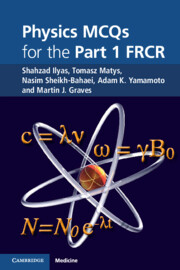Book contents
- Frontmatter
- Contents
- Preface
- Acknowledgements
- 1 Basic physics
- 2 Radiation hazards and protection
- 3 Imaging with X-rays
- 4 Film-screen radiography
- 5 Digital radiography
- 6 Fluoroscopy and mammography
- 7 Nuclear medicine
- 8 Computed tomography
- 9 Imaging with ultrasound
- 10 Magnetic resonance imaging
- Bibliography
- Index
7 - Nuclear medicine
Published online by Cambridge University Press: 05 July 2011
- Frontmatter
- Contents
- Preface
- Acknowledgements
- 1 Basic physics
- 2 Radiation hazards and protection
- 3 Imaging with X-rays
- 4 Film-screen radiography
- 5 Digital radiography
- 6 Fluoroscopy and mammography
- 7 Nuclear medicine
- 8 Computed tomography
- 9 Imaging with ultrasound
- 10 Magnetic resonance imaging
- Bibliography
- Index
Summary
Which of the following are true with regard to isotopes of a given element?
They have the same number of nucleons
They have the same atomic mass
They differ in densities
They have the same number of protons but a different number of electrons
They have the same position on the periodic table
Which of the following statements are correct, when referring to an atom?
The valence shell is responsible for radioactivity
Radioactivity results from an imbalance in the number of protons and electrons
All atoms have an equal number of protons and neutrons
Neutrons have a negative charge
Radon contributes to our background radiation
The production of radionuclides can involve:
The addition of a neutron into a stable nucleus
Capturing a negative electron from the K-shell (electron capture)
Addition of a proton into the nucleus using a nuclear reactor
The use of a cyclotron
Removal of electrons from the inner shell
Concerning radionuclide production:
Radionuclides used in medicine are generally found naturally
In a cyclotron, protons are forced into the nucleus
In a nuclear reactor, the addition of a neutron into the nucleus results in an increase in atomic number
Radionuclides produced in a cyclotron can be separated from the stable (carrier) element
[…]
- Type
- Chapter
- Information
- Physics MCQs for the Part 1 FRCR , pp. 85 - 97Publisher: Cambridge University PressPrint publication year: 2011



